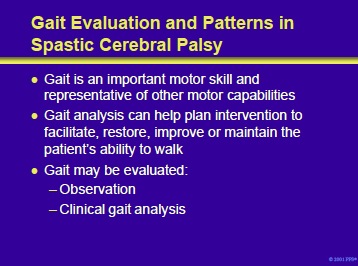
Gait is a series of multiple limb segment rotational movements that produce stable forward propulsion in an energy-conserving manner. It is an important motor skill and representative of other motor capabilities.
Although a number of atypical gait patterns have been described in patients with cerebral palsy, each patient has a unique set of impairments, functional limitations and associated compensations producing these patterns. Therefore, the mechanisms operative for an individual patient should be determined and are the basis for directing a tailored rehabilitation program.
Gait is studied in patients with cerebral palsy so that interventions can facilitate, restore, improve or maintain the patient’s ability to walk. Gait may be evaluated either observationally or with clinical gait analysis. Physicians commonly describe gait based upon observations during the initial and subsequent examinations.
However, it is often difficult to appreciate all limb segment and joint motions through different phases of the gait since all limbs and joints are moving at the same time in three-dimensional space. Therefore, observational gait evaluation can be supplemented by videotape taken while the patient is walking. Quantitative gait analysis is a particularly useful tool for developing a treatment plan.
Article Index
Page 17 of 26
Add comment